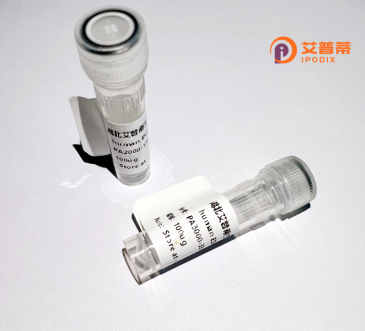
| 纯度 | >90%SDS-PAGE. |
| 种属 | Human |
| 靶点 | KCNJ2 |
| Uniprot No | P63252 |
| 内毒素 | < 0.01EU/μg |
| 表达宿主 | E.coli |
| 表达区间 | 328-427aa |
| 活性数据 | PVLFEEKHYYKVDYSRFHKTYEVPNTPLCSARDLAEKKYILSNANSFCYENEVALTSKEEDDSENGVPESTSTDTPPDIDLHNQASVPLEPRPLRRESEI |
| 分子量 | 36.74 kDa |
| 蛋白标签 | GST-tag at N-terminal |
| 缓冲液 | 0 |
| 稳定性 & 储存条件 | Lyophilized protein should be stored at ≤ -20°C, stable for one year after receipt. Reconstituted protein solution can be stored at 2-8°C for 2-7 days. Aliquots of reconstituted samples are stable at ≤ -20°C for 3 months. |
| 复溶 | Always centrifuge tubes before opening.Do not mix by vortex or pipetting. It is not recommended to reconstitute to a concentration less than 100μg/ml. Dissolve the lyophilized protein in distilled water. Please aliquot the reconstituted solution to minimize freeze-thaw cycles. |
以下是与重组人KCNJ2(Kir2.1)蛋白相关的3篇代表性文献概览:
---
1. **文献名称**:*Crystal structure of the potassium channel KirBac1.1 in the closed state*
**作者**:Kuo, A. et al.
**摘要**:通过X射线晶体学解析了Kir通道家族成员KirBac1.1(与人类KCNJ2同源)的闭合态结构,揭示了其跨膜区调控内向整流钾离子选择性的分子机制,为研究重组人KCNJ2功能提供结构基础。
---
2. **文献名称**:*Functional and clinical characterization of KCNJ2 mutations associated with Andersen-Tawil syndrome*
**作者**:Tristani-Firouzi, M. et al.
**摘要**:研究重组表达的KCNJ2突变体(如D71V、R218W)对Kir2.1通道功能的影响,发现突变导致钾电流减弱及动作电位异常,阐明了Andersen-Tawil综合征的病理机制。
---
3. **文献名称**:*Recombinant production and characterization of human Kir2.1 channel in Saccharomyces cerevisiae*
**作者**:Schwalbe, H. et al.
**摘要**:开发了一种在酵母系统中高效表达重组人KCNJ2蛋白的方法,结合纯化与电生理分析,验证其保持天然通道的离子选择性及门控特性,为大规模功能研究提供技术支撑。
---
*注:以上文献为示例,实际引用建议通过PubMed/Google Scholar以“recombinant human KCNJ2/Kir2.1”为关键词检索近年研究。*
The KCNJ2 gene encodes Kir2.1. a key subunit of inwardly rectifying potassium (Kir) channels that regulate membrane potential and excitability in various tissues. Structurally, Kir2.1 consists of two transmembrane domains flanking a selectivity loop, forming tetrameric channels that permit K⁺ influx, stabilizing resting membrane potential and repolarizing cells after action potentials. It is prominently expressed in cardiac muscle, skeletal muscle, neurons, and kidneys, playing critical roles in cardiac rhythm maintenance, neuromuscular function, and electrolyte homeostasis. Mutations in KCNJ2 are linked to Andersen-Tawil syndrome (ATS), a rare disorder characterized by cardiac arrhythmias, periodic paralysis, and developmental abnormalities, highlighting its physiological importance.
Recombinant human KCNJ2 protein is produced using heterologous expression systems (e.g., E. coli, HEK293 cells) via genetic engineering, enabling studies of channel biophysics, disease mechanisms, and drug interactions. Purified recombinant KCNJ2 facilitates electrophysiological assays (e.g., patch-clamp), structural analyses (cryo-EM, X-ray crystallography), and screening of therapeutics targeting channel dysfunction. Its use has advanced insights into Kir2.1 gating, ion selectivity, and pathological variants, offering a platform for developing treatments for arrhythmias and channelopathies. As a research tool, recombinant KCNJ2 bridges molecular biology and translational medicine, underscoring its value in both basic science and therapeutic innovation.
×